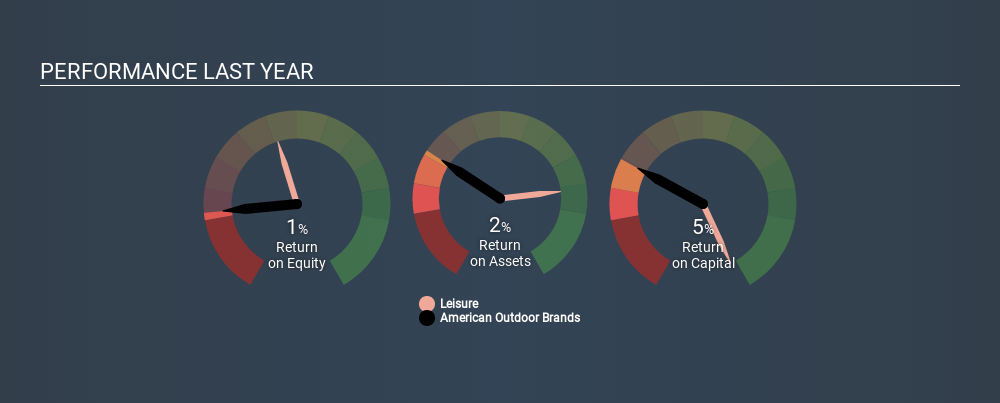- United States
- /
- Leisure
- /
- NasdaqGS:SWBI
Why American Outdoor Brands Corporation’s (NASDAQ:AOBC) Return On Capital Employed Might Be A Concern

Today we'll look at American Outdoor Brands Corporation (NASDAQ:AOBC) and reflect on its potential as an investment. In particular, we'll consider its Return On Capital Employed (ROCE), as that can give us insight into how profitably the company is able to employ capital in its business.
First up, we'll look at what ROCE is and how we calculate it. Second, we'll look at its ROCE compared to similar companies. And finally, we'll look at how its current liabilities are impacting its ROCE.
Return On Capital Employed (ROCE): What is it?
ROCE is a metric for evaluating how much pre-tax income (in percentage terms) a company earns on the capital invested in its business. Generally speaking a higher ROCE is better. In brief, it is a useful tool, but it is not without drawbacks. Author Edwin Whiting says to be careful when comparing the ROCE of different businesses, since 'No two businesses are exactly alike.
How Do You Calculate Return On Capital Employed?
The formula for calculating the return on capital employed is:
Return on Capital Employed = Earnings Before Interest and Tax (EBIT) ÷ (Total Assets - Current Liabilities)
Or for American Outdoor Brands:
0.047 = US$30m ÷ (US$809m - US$170m) (Based on the trailing twelve months to October 2019.)
Therefore, American Outdoor Brands has an ROCE of 4.7%.
See our latest analysis for American Outdoor Brands
Does American Outdoor Brands Have A Good ROCE?
ROCE is commonly used for comparing the performance of similar businesses. We can see American Outdoor Brands's ROCE is meaningfully below the Leisure industry average of 17%. This performance could be negative if sustained, as it suggests the business may underperform its industry. Putting aside American Outdoor Brands's performance relative to its industry, its ROCE in absolute terms is poor - considering the risk of owning stocks compared to government bonds. There are potentially more appealing investments elsewhere.
American Outdoor Brands's current ROCE of 4.7% is lower than its ROCE in the past, which was 36%, 3 years ago. This makes us wonder if the business is facing new challenges. You can see in the image below how American Outdoor Brands's ROCE compares to its industry. Click to see more on past growth.

When considering ROCE, bear in mind that it reflects the past and does not necessarily predict the future. ROCE can be misleading for companies in cyclical industries, with returns looking impressive during the boom times, but very weak during the busts. ROCE is, after all, simply a snap shot of a single year. What happens in the future is pretty important for investors, so we have prepared a free report on analyst forecasts for American Outdoor Brands.
Do American Outdoor Brands's Current Liabilities Skew Its ROCE?
Liabilities, such as supplier bills and bank overdrafts, are referred to as current liabilities if they need to be paid within 12 months. Due to the way the ROCE equation works, having large bills due in the near term can make it look as though a company has less capital employed, and thus a higher ROCE than usual. To counter this, investors can check if a company has high current liabilities relative to total assets.
American Outdoor Brands has current liabilities of US$170m and total assets of US$809m. As a result, its current liabilities are equal to approximately 21% of its total assets. With a very reasonable level of current liabilities, so the impact on ROCE is fairly minimal.
Our Take On American Outdoor Brands's ROCE
While that is good to see, American Outdoor Brands has a low ROCE and does not look attractive in this analysis. You might be able to find a better investment than American Outdoor Brands. If you want a selection of possible winners, check out this free list of interesting companies that trade on a P/E below 20 (but have proven they can grow earnings).
If you are like me, then you will not want to miss this free list of growing companies that insiders are buying.
If you spot an error that warrants correction, please contact the editor at editorial-team@simplywallst.com. This article by Simply Wall St is general in nature. It does not constitute a recommendation to buy or sell any stock, and does not take account of your objectives, or your financial situation. Simply Wall St has no position in the stocks mentioned.
We aim to bring you long-term focused research analysis driven by fundamental data. Note that our analysis may not factor in the latest price-sensitive company announcements or qualitative material. Thank you for reading.
About NasdaqGS:SWBI
Smith & Wesson Brands
Designs, manufactures, and sells firearms worldwide.
Excellent balance sheet with moderate growth potential.
Similar Companies
Market Insights
Community Narratives





